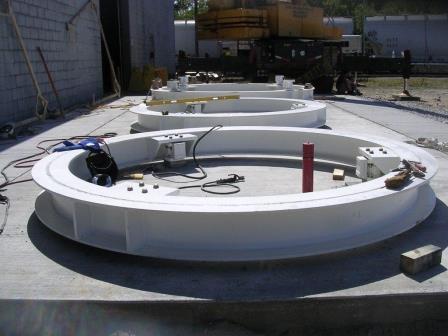An Accurate Weighing Solution for Aluminum Skirted Silos
May 28, 2014

Veka Inc. is a leading global plastics extrusion manufacturer of windows and doors in Fomball, PA. The plant manager had grown tired of the inaccuracies of volumetric measuring devices and calculations. The plant was just starting a new installation of an aluminum skirted silo in the summer of 2013 when the plant engineer contacted the Eagle Group in Greeneville, MI, to determine the best solution for accurate inventory control in the new silo.
Veka was facing a common dilemma using volumetric measurement, which determines the bulk inventory in skirted silos by raw material level measurement inside the silo, and then conversion of the level measurement to a calculated weight. This process is inherently error prone due to the material level variations in a large silo. The material in a silo – in this case powdered PVC plastic - is rarely evenly distributed and is characterized by cones, voids, and funnels caused by removing the powdered material from the bottom. Density and temperature fluctuations can also impact the accuracy of measuring by volume, especially with certain types of materials.
Weighing large vessels and silos using compression load cells is generally accepted as the most accurate and repeatable method to measure their contents, especially for inventory management. Roy Ferguson III, president of Eagle Group, contacted William Rosser of Hardy Process Solutions as the weighing partner for the 12-ft-wide by 88-ft-tall silo, the first load-cell based weighing system being used at this site. The Eagle Group had recently developed The Eagle Loadring, for accurate weighing of skirted silos. Although this was a new silo, the Eagle Loadring is designed to retrofit any existing silo. Veka also wanted to link the weight data directly into its manufacturing system and wanted a weight controller that could interface directly.
Safety Measures Built In
For safety, the Eagle Group uses finite element analysis and testing prior to installation, which meets local building engineering codes for determining the ability of the system to withstand wind shears of 90 to 100 mph. The Eagle Group installed all of the lugs inside the skirting so the load cells are protected from the environment and then sealed the outside of the silo with a rain/ice shield. With the full silo capacity of 460,000 lb, four high-capacity Hardy Advantage PRC03 load cells were used to measure accurately.
Due to sway primarily when the silo is empty, the PRC03 load cell mount assembly has several mechanisms for restricting movements of the structure. The first is an overload stop that is set with a 2mm gap. The stop restricts movement straight upward off the load stands. Two of the load cell mounts (in a 4-cell system) will be restricted as the structure will try to rotate as it is lifted. The second restrictor is a 5mm gap around the center shaft structure that restricts movement side to side. This center shaft is parallel to the load cell, goes through the top plate, and is welded to the bottom plate of the mount. Obviously, if we are restricting movement side to side, the structure will bottom out there as well. Finally, the load cell itself is designed to be somewhat restrictive. As the load point has a spherical top and bottom the unit as it “tips” will become longer and then gravity will force it back to the centerline of the structure. The more weight (material) in the silo the more limited this travel becomes.
C2 Calibration
To deliver the inventory control readings to the company’s manufacturing computer network, the Hardy PRC03 load cells were connected to a Hardy junction box and connected to a Hardy HI 4050 weight controller via C2 cabling.
Unlike calibration with test weights, the silo doesn’t have to be emptied and heavy test weights do not have to be repeatedly put on and off with C2. As soon as the scale system was installed, it was C2 calibrated, and proper scale installation verified. The result is calibration that is easier, quicker, safer, and typically more accurate. The C2 system saves time and money, while delivering accurate inventory within just a few lb for a silo with 460,000 lb capacity. Veka is impressed with the accuracy and is installing three more silos in the summer of 2014.
Eagle is a manufacturer of storing, mixing, conveying, and dumping equipment for chemical, plastic, food, pharmaceutical, and biofuels applications. The company is also a supplier of accessories and components used in the assembly of material conveying systems. For more information, call 616-754-7777 or visit www.eaglegroupltd.com.
Hardy provides process measurement solutions that reduce waste, increase productivity and improve quality. Hardy offers a broad line of process weighing instrumentation, sensors, and scales for use in a variety of applications including mixing/blending, filling/dispensing, check weighing, rate control/monitoring, level by weight, and force measurement. For more information, call 800-821-5831 or visit www.hardysolutions.com.
For related articles, equipment reviews, and news, visit our Weighing Systems & Scales Equipment Zone
You May Also Like

